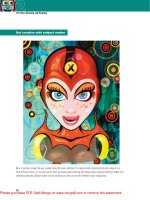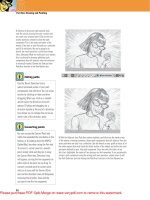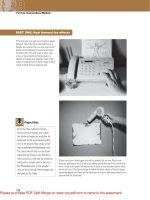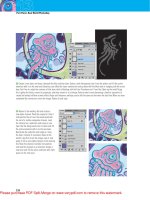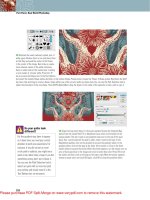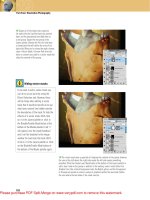creative photoshop digital illustration and art techniques - Phần 6 docx
Bạn đang xem bản rút gọn của tài liệu. Xem và tải ngay bản đầy đủ của tài liệu tại đây (11.35 MB, 38 trang )
174
Creative Photoshop
Part 3: Illustrative Photography
6 I When you’re satisfied with the mask, flatten the image and then
select the Pen tool. In the tool options bar, ensure that the pen is set to
create paths and not shape layers. Also ensure that the add to path area
option is selected. Use the Pen tool to carefully trace the contour of
her iris on the left side of the image. Create a closed path component
by returning to the starting point. Now, in the Paths palette, generate a
selection from the path by Control-Clicking(PC)/Command-clicking(Mac)
on the Path thumbnail.
Building up luminous eye effects
Use a series of different layers to begin stacking up the luminous eye effect that give our alien her other-worldly stare.
1 I Choose LayerϾNewϾLayer Via Copy
from the menu to create a new layer
containing the selection contents. Choose
ImageϾAdjustmentsϾLevels from the menu
and drag the center input slider to the left to
lighten the iris midtones. Drag the left slider
toward the right a little.
2 I Control(PC)/Command(Mac)-click your
la
yer thumbnail to generate a selection
from it. Then create a new hue/saturation
adjustment layer. Enable the colorize option
and then manipulate the sliders to give the
iris a bright blue hue. Select the magic wand
tool when finished.
3 I Click on a blue area of the iris to
gener
ate a selection from it. Create a new
layer and then add a white to transparent
radial gradient inside the active selection
on your new layer. Change the layer blending
mode to overlay.
Ch12-K52046.indd 174Ch12-K52046.indd 174 6/21/07 11:41:18 AM6/21/07 11:41:18 AM
175
Creature Architecture
Chapter 12
7 I Duplicate the top layer and change the blending mode to
screen, this adds some white into the iris. Reduce the opacity
of the top layer to 40% or so. Now, go ahead and add layer
masks to the top two layers and use the aforementioned gradient methods to blend any hard edges or mask out any unwanted areas
from the individual layers. Target the top layer and then, while holding down the shift key, click on the iris layer that sits just above the
background layer. This targets both layers as well as all layers in-between within the layers palette.
Smoothing
Leaving the smoothing option enabled
in the brushes palette will allow you to
produce smother curves while you paint.
It is very useful to those of you who are
painting quickly with a stylus instead of a
mouse, but if you are painting very quickly
you may notice a slight delay while your
finished strokes are rendered on the
screen.
8 I With multiple layers targeted in the layers palette, choose LayerϾNewϾGroup
From Layers from the menu. This creates a new group containing all of the layers.
Go ahead and name it ‘iris’. Deselect any currently active selections and click the
add layer mask button in the layers palette to add a mask to your group. Select the
brush tool. In the brushes palette, choose a soft, round, brush tip preset. Disable all
of the brush dynamics from the column at the left with the exception of smoothing.
Zoom in close on the iris.
Ch12-K52046.indd 175Ch12-K52046.indd 175 6/21/07 11:41:23 AM6/21/07 11:41:23 AM
176
Creative Photoshop
Part 3: Illustrative Photography
9 I Adjust the master diameter of your brush in
the brushes palette, so that it is about half as
wide as her pupil. Target the iris group mask in
the layers palette and then, while using a black
foreground color, paint over all of the hard
edges around the perimeter of the iris. Next, in
the tool options bar, reduce the opacity of the
brush considerably, and paint over areas of the
iris within the layer mask that you want to soften.
Try working with a variety of opacity settings to
get the best results.
Duplicating groups
Duplicating a group is done exactly the same way
as duplicating a layer. You still have a number
of options when it comes to exactly how you
create your duplicate. You already know that
you can drag the group onto the create a new
layer button in the layers palette, but the other
duplication methods will work as well. You can
target your group and then choose Duplicate
Group from the Layer menu in the main menu
or from the Layers palette menu. Also, you can
control-click(Mac)/right-click(PC) on the layer in
the Layers palette and then choose the duplicate
group option from the resulting pop-up menu. In
every case, the procedure is exactly the same as
duplicating a single layer, except for the fact that
Duplicate Layer is replaced with Duplicate Group
within any menu you decide to use.
10 I In the layers palette, drag the iris group onto the create a new layer button to duplicate the
entire group. With the duplicate group targeted, Choose EditϾTransformϾFlip Horizontal from
the menu to flip the duplicated iris group. Select the move tool. While holding down the shift key,
use the move tool to drag the duplicate group across the canvas so that it rests perfectly on top
of the other eye.
Ch12-K52046.indd 176Ch12-K52046.indd 176 6/21/07 11:41:27 AM6/21/07 11:41:27 AM
177
Creature Architecture
Chapter 12
11 I Now that you’ve completed the iris effects, we’ll
begin to add some of the stone details to her face.
Start by opening up the piece1.psd file. Use the move
tool to click on the stone detail and drag it into your
working file as a new layer. Position the contents of
the new layer on the canvas, so that the stone detail
overlaps her cheek at the right. Next, duplicate the
layer, change the blending mode of the duplicate layer
to screen, and reduce the opacity to 10%.
12 I Control(PC)/Command(Mac)-click on the top
la
yer’s thumbnail to generate a selection from the
contents of the layer. Now, with the new selection
active, select the eyedropper tool and click on
an area of her skin to sample it. This will set
the foreground color to the new sampled color.
Create a new layer and then fill the contents
of the selection on the new layer by choosing
EditϾFill from the menu. And finally, change the
blending mode of this new layer to color and
deactivate the current selection.
Precise dragging
When you are dragging layers from one file to
another, it is likely that you’ll need to reposition
the layer on the canvas once it is in your
destination file. However, if your source
and destination files have the exact same pixel
dimensions, try holding down the shift key while
dragging your layer from file to file. This will
place the layer in your destination file, in the
exact same position on the canvas area as it
was in your source file.
Dragging multiple layers
You can drag more than one layer at a time from
file to file. First, simply target more than one
layer in the layers palette. Next, click on any one
of the targeted layers and drag it into the image
window of any other open file. The layer you
dragged will be added to the destination file,
as well as all of the additional layers that were
targeted in the layers palette of the source file.
Ch12-K52046.indd 177Ch12-K52046.indd 177 6/21/07 11:41:32 AM6/21/07 11:41:32 AM
178
Creative Photoshop
Part 3: Illustrative Photography
13 I At the moment, your top layer should be
targeted in the layers palette. Hold down the
Control(PC)/Command(Mac) key and then click
on the two layers beneath it that contain the
stone detail, to target them as well. Now that the
top three layers are targeted, choose LayerϾ
NewϾGroup From Layers from the menu to add
them to a group. Once they are grouped, add
a layer mask to the group and ensure that the
mask remains targeted in the layers palette.
14 I Use the lasso tool to draw a rough selection on the layer mask that traces the
contour of the stone detail.
Then invert the selection by choosing SelectϾInverse
from the menu. Fill the inverted selection on the targeted layer mask with black
and then deactivate the selection. This will remove the straight edges contained
within the original file. Next, with your group targeted in the layers palette, choose
LayerϾMerge Group from the menu to merge the entire group into a single
masked layer. Now, drag your layer mask into the trash in the layers palette to
remove it. When prompted, click the apply button.
Merging groups
As is true with many Photoshop functions,
you can access the merge group function
in a number of different places. First,
target your group in the layers palette,
and then you can either choose Merge
Group from the Layer menu or from the
Layers palette menu. In addition to these
methods, you can always right-click(PC)/
control-click(Mac) on the group itself
within the Layers palette. A pop-up menu
will appear and you can choose the Merge
Group option from the list. However, the
quickest method, and the one you should
familiarize yourself with, is the keyboard
shortcut. Simply target your group in the
layers palette and then type Control(PC)/
Command(Mac)-E on the keyboard.
Ch12-K52046.indd 178Ch12-K52046.indd 178 6/21/07 11:41:36 AM6/21/07 11:41:36 AM
179
Creature Architecture
Chapter 12
15 I Next, select the rectangular marquee tool and draw a
rectangular marquee that contains the stone detail as well as
a fair amount of the background image within the selection
border. You need an ample amount of space between the stone
detail and the selection border for this effect to work out
properly. Once you’ve made your selection, ensure that your
newly merged layer is targeted in the layers palette. Then
choose FilterϾDistortϾSpherize from the menu. Increase the
amount considerably to add the necessary contour to the stone
detail and then click OK.
Completing the spherize effect
Before moving onto masking or another piece of stone detail, this piece still needs a little bit of finesse to make it work.
1 I Deactivate the selection and then choose
EditϾF
ree-Transform from the menu. Hold
down the Control(PC)/Command(Mac) key while
dragging the corner points of the bounding box
to freely distort the contents of the layer, making
it fit her cheek area better.
2 I Press Enter on your keyboard to apply your
tr
ansformation. Draw another rectangular selection
around your stone detail like you did before using
the Spherize filter earlier. Next, just choose FilterϾ
Spherize from the menu to repeat the previous
spherize effect.
3 I Deselect and again, use
the same F
ree-Transform
method while holding
down the Control(PC)/
Command(Mac) key to adjust
the shape, making it fit her
face better. Sometimes a bit of
repetition is necessary to get
the effect you’re after. Press
Enter and add a layer mask.
Ch12-K52046.indd 179Ch12-K52046.indd 179 6/21/07 11:41:41 AM6/21/07 11:41:41 AM
180
Creative Photoshop
Part 3: Illustrative Photography
16 I Target your layer mask in the Layers palette and then select the brush tool. Choose a
soft, round brush tip preset and disable any brush dynamics in the Brushes palette. Use the
brush, with a foreground color of black, to paint within the mask. Vary the brush diameter in
the Brushes palette as well as the opacity in the tool options bar. Varying the size and opacity
will allow you perform large, gentle mask effects, as well as more drastic, smaller, and precise
effects. Continue masking until the stone detail begins to look like what you see here.
17 I Now, to add a different stone detail to the same area of her face, open up the piece2.jpg file. Use the move tool to drag the ima
ge into your working
file as a new layer. Reduce the opacity of your layer in the layers palette so that you can see the underlying image and position it so that it fits nicely
within the composition, overlapping her existing cheek detail. Next, return the layer to full opacity and select the Pen tool. Ensure that the paths option
and the add to path area option are both enabled in the tool options bar.
Choosing details
The process described here will definitely
have you producing impressive results when
it comes to blending different photographic
elements into people. However, one of the most
important, and often overlooked, parts of the
process is selecting just what to use. I took over
70 photos of various architectural details with
this image in mind. Before I began the process
of compositing within Photoshop, I spent a lot of
time looking at all of the detail photos. Rotating
them, flipping them, assessing which particular
detail was appropriate for which portion of
her face, etc. It is necessary to spend the time
planning what to use ahead of time so that you
don’t spend hours adding various elements
into your image, only to find that at the end of
it all they don’t work. Whether you’re adding
architectural details or something else entirely,
a little forethought goes a long way in the end.
Ch12-K52046.indd 180Ch12-K52046.indd 180 6/21/07 11:41:45 AM6/21/07 11:41:45 AM
181
Creature Architecture
Chapter 12
18 I Draw a closed path that surrounds the piece
of detail. Generate a selection from the new path in
the paths palette using the same methods as you did
previously with the iris path. Choose SelectϾInverse
from the menu and then press the delete key to remove
the unwanted portions from this layer. Duplicate
the layer. Change the duplicate layer’s blending
mode to screen to lighten the detail. Control(PC)/
Command(Mac)-click on the layer thumbnail to load
a selection from the contents of your new duplicate
layer. With the new selection active, create a new layer
and fill the active selection with a color sampled from
her skin via the eyedropper. Change the blending mode
of the layer to color.
Reshaping the stone detail
You’ll notice this fundamental process begin to repeat itself as we use free-transform and spherize to customize this piece of
detail too.
1 I Deselect, then target all three layers that make up this new piece of
detail and merge them by choosing LayerϾMerge Layers from the menu.
Select EditϾFree-Transform from the menu. Hold down the Control(PC)/
Command(Mac) key while dragging the corner points of the box to
reshape the detail.
2 I Press Enter to apply the
tr
ansformation and then use the
rectangular marquee tool to draw
a generous selection around it
that includes sufficient space all
around. Choose FilterϾDistortϾ
Spherize from the menu and again,
use the filter to add curvature to
the detail.
3 I After you apply the filter, like
last time
, you’ll need to tweak
the detail by transforming and
possibly spherizing again. When
you’re happy with the results add a
layer mask. Again, use a soft brush,
with varying size and opacity,
to paint within the mask, gently
blending the detail.
Ch12-K52046.indd 181Ch12-K52046.indd 181 6/21/07 11:41:50 AM6/21/07 11:41:50 AM
182
Creative Photoshop
Part 3: Illustrative Photography
19 I Target the two layers that contain stone
details in the layers palette and merge them into
one. Target the new, merged layer, and repeat the
process of spherizing within a large rectangular
selection border to add some curvature to the
newly merged details together. Next, add a layer
mask and use the paintbrush method employed
previously to gently fade areas of this layer into
the background, by painting within the mask
using various opacity and size settings.
20 I Open up the detail.psd file. Use the move tool
to dr
ag the layer into your working file as a new
layer. Use Free-Transform to resize, reshape, and
position the new detail to the side of her face by her eyebrow. Duplicate the layer
and change the blending mode of the layer to screen. Generate a selection from
the contents of this layer. Now, create a new layer and fill the selection with a pink
color sampled from her skin. Change the layer blending mode to color.
Why screen?
You’ve probably noticed by now that when
I want to lighten a layer by placing a
duplicate of that layer on top of it, the
blending mode I reach for is screen.
People often think literally when it comes
to lightening one layer with another and
tend to reach for the lighten blending
mode instead. That is fine if your top layer
contains lighter colors. However, if it is
an exact duplicate, like we’re using here,
there will be no visible effect. Choosing
the screen blending mode is excellent for
this because it multiplies the inverse of
the blended colors, resulting in a bleach
effect, lightening the base layer with an
exact duplicate on an overlaying layer.
Ch12-K52046.indd 182Ch12-K52046.indd 182 6/21/07 11:41:55 AM6/21/07 11:41:55 AM
183
Creature Architecture
Chapter 12
21 I As you’ve done previously in this chapter,
create a new group containing the three newest
layers. Add a mask to the group and select the
brush tool. Paint with varying opacity settings
and a soft round tip, to gently fade the layers
within the group into the background by painting
black into the mask. Remember to vary the size
of the brush tip as required. Don’t bother with
the top of the detail or the right-hand side. Open
up the detail1.psd file.
22 I Use the move tool to drag the layer from
the detail1.psd f
ile into your working file as
a new layer. This stone detail is light enough
that we don’t require a duplicate layer with a
different mode to lighten it. This time, simply
generate a selection from the contents of the layer and then create a new layer.
As you’ve done previously, fill the selection with skin color on the new layer and
change the layer blending mode to color. Add both layers to a group. Mask the
group and then edit the mask like you’ve done previously with the brush tool.
Layer destinations
When you drag the detail1.psd file into
the working file you’ll probably notice
that it goes into your existing layer group
in the layers palette. This is because the
layer group was targeted in your working
file when you dragged the layer from
the detail1.psd file into it. Obviously you
don’t want this layer to reside within the
existing group, so to move it out, begin by
clicking on your layer in the layers palette
and dragging it upward. Drag it above
the current group until you see a dark
horizontal line appear just above the set in
the layers palette. When you see this line,
let go of the mouse button and your layer
will be placed above the group, outside of
it, in the layers palette.
Ch12-K52046.indd 183Ch12-K52046.indd 183 6/21/07 11:41:59 AM6/21/07 11:41:59 AM
184
Creative Photoshop
Part 3: Illustrative Photography
23 I Open up the detail2.psd file and
drag the image into the working file
as a new layer. Move the layer out of
any groups it may have fallen into
and drag it to the top of the layers
palette. Use Free-Transform to resize
and place it just above her eye.
Duplicate the layer, change the mode
to screen, and reduce the opacity to
56%. Duplicate this layer and then
change the blending mode to soft light,
adding contrast. Reduce the opacity
of this layer a little more. Generate a
selection from the layer and create a
new layer while the selection is active.
24 I Again, as you’ve done previously with the other
detail la
yer stacks, fill the selection on the current
layer with skin color and change the blending mode
to color. Deselect and then create a new group that
contains all of the detail 2 layers. Add a mask to the
group and then edit the mask with the brush tool,
painting with black, like you’ve done previously to
blend the detail into the underlying face. Vary the
brush size and opacity as required and even use the
gradient tool to create larger, sweeping blend effects.
Group advantages
When you’ve created a stack of layers,
grouping the layers is always a much
better option than merging if at all
possible. By keeping layers separated
within the groups you can edit things at
any point later on. You can increase or
decrease layer opacity, alter a blending
mode, or even add and edit individual layer
masks. So by keeping things separate,
you are affording yourself the luxury of
changing your mind layer on. Now, in some
cases, like when you want to add a spherize
effect to a stack of layers, you’ll need
to merge the layers first. But whenever
possible, you should try to keep everything
within your file as separate as you can for
further editing.
Ch12-K52046.indd 184Ch12-K52046.indd 184 6/21/07 11:42:04 AM6/21/07 11:42:04 AM
185
Creature Architecture
Chapter 12
25 I It is safe to assume that at this point that you can’t ignore the repeating pattern that is emerging here. Every time you add a new
element you place it as a layer in the image, resize and position it exactly where you want it. Then you duplicate it, alter the blending
mode to enhance it, and repeat if necessary. Finally, you generate a selection from your layer contents, fill the selection with skin color
on a new layer, and change the blending mode of the new layer to color. Open up the detail3.psd and detail4.psd files.
26 I Use all the methods we’ve used so far to introduce each element into the
ima
ge. Bring them in as layers, use duplication, blending modes, color fills, and
masked sets. It is unlikely that you aren’t familiar with the process at this point as
we’ve gone through it a few times already. Position each of these new detail groups
above the large eyebrow detail. Collapse all of your groups in the layers palette to
conserve space. Target every group except the two iris groups and the background
layer. Choose LayerϾNewϾGroup From Layers from the menu. Then choose
LayerϾDuplicate Group from the menu to copy the new group.
Groups within groups
At this point you’re well aware of the advantages
of grouping layers. However, it is important that
you don’t forget that you can group groups as
well. This adds another level of organization to
your files. Again, grouping rather than merging
affords you the luxury of editing individual
groups later on. In addition to this, grouping a
number of groups allows you move, duplicate,
and transform large numbers of layers together
at the same time. In this particular case, all
of the stone detail groups are now neatly
contained within a single group, making it easy
to duplicate and flip them to the other side of
the face, preserving all blending operations as
well as their special relationships to each other
within the image.
Ch12-K52046.indd 185Ch12-K52046.indd 185 6/21/07 11:42:08 AM6/21/07 11:42:08 AM
186
Creative Photoshop
Part 3: Illustrative Photography
27 I With the duplicate group
targeted in the layers palette,
choose EditϾTransformϾ
Flip Horizontal from the
menu. It may take a moment
to perform this operation as
Photoshop has a lot to think
about here, but just like that,
you’ll see the duplicate detail
flip over and position itself
on the other side of her face.
You can move it a little with
the move tool, just be certain
that you’re holding down the
shift key while you click and
drag sideways to avoid any
unwanted vertical movements.
28 I Open up the column.psd file. Use the move
tool to dr
ag the layer into your working file as a
new layer and position it at the top of the canvas.
In the layers palette, drag the new layer down so
that it sits above the background, but underneath
all of the other layers and groups. Use the Gaussian
Blur filter to add a slight blur to the contents of
the layer. Duplicate the new layer and change the
blending mode of the duplicate layer to screen.
Then, duplicate the duplicate layer and change the
blending mode to soft light.
Further Masking
Now that you have the face details separated into
two groups, you may notice visible layer artifacts
here and there that you don’t want to see in your
image. To remedy this, go ahead and add a mask
to either or both of your stone detail groups. Use
the Brush tool or a series of gradients to gently
mask out any areas you don’t want to be visible.
Try editing the masks of the two halves a little
differently here and there, so that they don’t look
exactly the same as each other. You still want a
mirror image effect across her face, but mask
editing allows you to introduce a little bit of
subtle individuality to each side.
Ch12-K52046.indd 186Ch12-K52046.indd 186 6/21/07 11:42:13 AM6/21/07 11:42:13 AM
187
Creature Architecture
Chapter 12
Adding lighter areas
Now that the details are in place, it is time to begin smoothing out her skin with some lighter colors.
1 I Create a new layer that sits above your column group in the layers palette. With this
layer targeted, use the Pen tool to draw a closed path that surrounds her forehead.
Ensure that the path overlaps, but does not extend below, her eyebrow details.
2 I Generate a selection from
the path and then change the
la
yer blending mode to lighten.
Use the radial gradient tool, set
at foreground to transparent,
to create gradients within the
selection at varying opacities.
Sampling various skin colors as
you go.
3 I Deselect and use the brush tool, with varying
opacity settings and a soft r
ound tip, to paint over
dark blemishes and unwanted areas on this layer with
colors sampled from neighboring areas. Hold down
alt(PC)/option(Mac) while using the brush to sample
colors as you work.
29 I Generate a selection from the contents
of your newest duplicate layer and, with
the selection active, create a new layer on
top of it in the layers palette. Fill the active
selection on the new layer with skin color,
change the layer blending mode to color,
and deselect. Add a new group containing
all of your column layers and add a mask to
it. Edit the mask with the brush and gradient
tools to gently blend the column group of
layers into her forehead.
Ch12-K52046.indd 187Ch12-K52046.indd 187 6/21/07 11:42:18 AM6/21/07 11:42:18 AM
188
Creative Photoshop
Part 3: Illustrative Photography
30 I Next, create another new layer, ensure that it sits
above the previous ‘lighten’ layer you were just working
on in the layers palette. Change the blending mode of
this layer to multiply and then select the gradient tool.
This time, select the linear gradient method but leave
the preset set at foreground to transparent. Sample a
dark background color from the image and then draw
a gradient from each corner inward slightly to darken
the edges of the image.
31 I Now that the illustrative portion of the image is complete, the
next sta
ge is to alter the color. The first step in achieving this ghostly
gray look is to increase the contrast. Target the top layer in your
layers palette, so that any new layers we create will automatically
reside above all of the others in the layers palette. Choose LayerϾ
New Adjustment LayerϾLevels from the menu. Drag the input level
sliders from the left- and right-hand sides toward the center until you
see the overall contrast increase. If the midtones get too dark, drag
the center input level slider to the left until they improve.
Multiply versus darken
In order to add the burn or darkening effect
around the edges, I created a number of dark
colored gradients, extending from the corners
inward, on a layer with the blending mode set to
multiply. Because the desired effect is to darken,
you might wonder why I did not use the Darken
blending mode instead. The Darken blending
mode looks at the color on the active layer and
the color on the underlying layers and displays
whichever is darkest. However, Multiply blending
mode does not compare colors, it simply
multiplies the underlying color by the color on
the layer, resulting in a much darker color than
the color on either layer. Because of this, the
multiply blending mode gives a more drastic
darken effect than the darken blending mode.
Ch12-K52046.indd 188Ch12-K52046.indd 188 6/21/07 11:42:23 AM6/21/07 11:42:23 AM
189
Creature Architecture
Chapter 12
32 I Choose LayerϾNew Adjustment LayerϾHue/
Saturation from the menu. Adjust the hue to 211, and
decrease the saturation to almost nothing. This will
remove a great deal of color from the image. Change
the blending mode of the Hue/Saturation layer to color
and reduce the opacity considerably in the layers
palette. She still needs a bit of color in her complexion
to work with. Now, we want to make things appear a
little more blue, so choose LayerϾNew Fill ColorϾ
Solid Color from the menu.
33 I In the New Layer options, set the blending mode to color and reduce the opacity to 80%.
Once you c
lick OK the picker will appear. Select a nice, bright blue color from the picker and
click OK. You’ll immediately notice that the effect is much too strong. To remedy this, drag the
Fill slider down to 10% in the layers palette. Now you’ll notice the effect is a little too soft.
Remedy this by simply duplicating the solid color fill layer.
Undoing adjustments
When you add an adjustment or fill layer, you’ll
notice that the underlying image is effected in
its entirety. However, you may notice specific
details in the image, like her iris and lip areas
in this case, that you want to remain unaffected
by one or all of the adjustment layers. If this is
what you’re after, simply target an adjustment
or fill layer’s mask in the layers palette. You can
edit an adjustment or fill layer mask exactly
like you edit any other layer mask. Adding black
to the mask will hide the effect of the layer in
that area, so if you want her iris areas to be
unaffected by one of your adjustment or fill
layer, simply paint over that area within the
specific layer’s mask.
Ch12-K52046.indd 189Ch12-K52046.indd 189 6/21/07 11:42:28 AM6/21/07 11:42:28 AM
190
Creative Photoshop
Part 3: Illustrative Photography
34 I The effect is almost
complete. However, achieving
a very desaturated color cast
can be tricky. Sometimes your
images can look too warm or
too cool. In this case, it looks
a touch too warm. In order to
remedy this, choose LayerϾ
New Adjustment LayerϾ
Selective Color from the menu.
Choose neutrals from the color
menu. Increase the amount
of cyan slightly, while equally
reducing the amount of yellow. The result will be subtle, but it helps cool the
image overall.
Adding surface texture
Now that the color adjustments are complete, the final stage is to add a textured effect.
1 I Open the texture.psd file. Use the
mo
ve tool to drag it, while holding
down the shift key, into the working file
as a new layer at the top of the layers
palette. Change the blending mode to
lighten and reduce the opacity to 76%.
2 I Duplicate the layer and change
the blending mode of the duplicate to
soft light.
Add both of these layers to a
new group and then add a layer mask
to the group. Select the gradient tool
and target the group’s mask in the
layers palette.
3 I Choose the radial gradient method
and the f
oreground to transparent
preset in the tool options bar. Using a
black foreground color, click and drag
within the mask to create a variety
of gradients, masking the texture
overlapping the center of her face.
Ch12-K52046.indd 190Ch12-K52046.indd 190 6/21/07 11:42:33 AM6/21/07 11:42:33 AM
191
Creature Architecture
Chapter 12
35 I Now, duplicate the top-most texture
layer within the group. Click on it and drag
it out of the group within the layers palette.
Ensure that it is on top of the group and at
the top of the entire layer stack within the
layers palette. Increase the opacity of the
layer to 100% and ensure that the blending
mode is set to soft light. Add a mask to this
layer. Use the gradient tool, set up exactly
the way it is, with varying opacity settings
to edit the layer mask, adding gradients to
reveal the underlying face.
Final inspection
Let’s take one last look at the image, and examine which techniques will prove useful later on, when you’re creating other images on your own.
a I This cheek detail was made perfect by transforming
and spher
izing, then repeating the process. It is important
to be willing to repeat a process as many times as it takes
until things look just right.
b I Adding a blur effect to not only this crown, but also to
the outer edges of her f
ace and neck, adds a nice depth of
field effect, while removing amateurish hard edges.
c I Painting and adding gradients on a layer with a lighten
blending mode allows you to smooth out her f
orehead
nicely. It also preserves any highlights underneath that are
lighter than the colors on your layer.
d I Creating details on half of her face and then
duplicating them not only pr
ovides a sense of surrealistic
symmetry, but it also saves a massive amount of time.
e I Adding a rough surface texture to the entire image not
only helps to br
ing it all together, but it also creates an
illustrated feeling that helps the image to transcend that
of basic photographic collage.
a
b
d
c
e
Ch12-K52046.indd 191Ch12-K52046.indd 191 6/21/07 11:42:38 AM6/21/07 11:42:38 AM
192
Creative Photoshop
Part 3: Illustrative Photography
Once you master the technique of building up layer stacks and working with groups, you’re only limited by your
imagination. This image was created using the same techniques, but instead of stone details, I decided to create a
mythical green woman by incorporating desktop scans of leaves.
192
Creative Photoshop
Ch12-K52046.indd 192Ch12-K52046.indd 192 6/21/07 11:42:43 AM6/21/07 11:42:43 AM
193
Creature Architecture
Chapter 12
Again, here is another fine example of the same techniques, using different photographic resources. You can blend
almost anything into a human face and make the result look convincing if you abide by the methods explained previously
in this chapter.
Ch12-K52046.indd 193Ch12-K52046.indd 193 6/21/07 11:42:49 AM6/21/07 11:42:49 AM
Ch13-K52046.indd 194Ch13-K52046.indd 194 6/21/07 11:43:49 AM6/21/07 11:43:49 AM
Chapter 13
The Third
Dimension
A
s an artist who works digitally, when I hear the words 3D I
think of software. Programs like Maya, SoftImage, and Cinema
4D come to mind. I think of building objects in 3D space,
adding light, texture, and rendering. The right software package
can certainly assist in creating amazing works of 3D art, however, those
who are accustomed to working in 2D may find the steep learning curve
a little daunting. As someone who grew up drawing and painting, I have
found that working in a 3D program is just never as intuitive as working on
a flat canvas. For years I have been working with a variety of 3D programs,
but I always find myself struggling against the software at some stage in the
process. I have the idea in my head or on paper, and it generally seems to be
a battle to get it the way I want it within the software. In short, nothing was
ever as effortless or intuitive as working within Photoshop.
It was the work of traditional artists, especially M.C. Escher, that got
me thinking of just illustrating my 3D effects the old fashioned way. These
artists never had any 3D software, they just sat in their studios and drew or
painted what was in their heads. I finally decided that there was no reason
why I, as an illustrator armed with Photoshop, couldn’t do the same thing
digitally, and the image you see here is my most successful attempt so far.
As you work through the process of recreating this image on the following
pages, you see that although we’re using Photoshop instead of a pencil or
paintbrush, the fundamental process of creating 3D effects is quite similar
to traditional methods of drawing or painting in perspective.
Admittedly, a program like Photoshop places us at a distinct advantage
as far as tools are concerned. M.C. Escher never had the opportunity to
work with layer masks, or enjoy the freedom of multiple undos. However,
even though we’ve got an arsenal of excellent tools at our disposal, you’ll
notice that as soon as you begin to create the peeling head effect you see
here, you’re pondering many of the same things Escher himself must’ve
pondered. No matter how advanced your tools are, you still need to use
your brain. In order to create something impressive, you always need to
visualize what you want first.
195
Ch13-K52046.indd 195Ch13-K52046.indd 195 6/21/07 11:44:05 AM6/21/07 11:44:05 AM
196
Creative Photoshop
Part 3: Illustrative Photography
1 I Open up the face.psd file from the CD.
Initially you’ll notice that this image appears
a little soft, so the first thing we need to do is
sharpen it. Choose FilterϾSharpenϾSmart
Sharpen from the menu. Basic mode is fine for
this simple task. Increase the amount to around
100 and set the pixel radius to 1. Leave the
remove option set to Gaussian Blur. Although
we’re going to drastically alter this image
before it’s finished, a little sharpening will help
in areas that will remain largely untouched, like
his eyes.
2 I Select the lasso tool and draw a rough selection that surrounds one of his eyes.
Then, while holding down the shift key, draw another rough selection that surrounds
his other eye, and then draw another that surrounds his lips. With both eyes and his
lips surrounded by selections, choose SelectϾModifyϾFeather from the menu.
Here I decided to use a radius of 5 pixels to create a gentle soft edge, however,
depending upon the resolution you’re working at, this number may vary. With the
feathered selection active, choose LayerϾNewϾLayer Via Copy from the menu.
Temporarily disable the visibility of the background layer to view the new layer
you’ve created from the selected contents.
Project files
All of the files needed to follow along with
this chapter and create the featured image
are available on the accompanying CD.
Files for this chapter can be found in the
folder entitled: chapter_13.
Feathering selections
In this instance, I created a selection
and then feathered it to soften the edges
after the fact. However, when you choose a
selection tool like the lasso or a marquee
tool, take a look in the tool options bar and
you’ll see a feather function there. You can
enter a pixel radius and then every time
you create a selection with that tool your
selection will be feathered instantly. This
value remains set until you change it, even
when switching back and forth between
tools.
Ch13-K52046.indd 196Ch13-K52046.indd 196 6/21/07 11:44:08 AM6/21/07 11:44:08 AM
197
The Third Dimension
Chapter 13
3 I With your new layer targeted, use the lasso tool to draw a selection that completely
surrounds one of the eyes. Once selected, choose EditϾFree-Transform from the
menu. Use the corners and midpoint handles of the bounding box to increase the eye
in size and alter the proportion so that it is larger and wider than the original. Press
Enter on the keyboard and then repeat the process with the other eye and the lips,
until all elements on this layer have been edited individually with the free-transform
tool. Enable the visibility of the background layer when finished.
4 I With your top layer targeted in the layers palette, hold down the shift key and
then click on the background layer. This will allow you to target both of your layers
at the same time. Now, with both layers targeted, choose LayerϾSmart ObjectsϾ
Convert to Smart Object. This converts your layers into an editable smart object.
With the smart object targeted in the layers palette, choose FilterϾBlurϾGaussian
Blur from the menu. Enter a substantial radius value to blur the smart object
considerably and click OK.
Checking position
When you alter the eyes and mouth on
the new layer you may find it difficult to
visualize how they will appear against the
face in the background because at this
stage the background layer’s visibility is
disabled. The best way to see if things are
working out is to enable the background
layer visibility after each free-transform
operation. Then you can see how the
transformed facial feature fits within the
face on the underlying layer. If you don’t
like the result you can always undo the
transformation and try it again, bearing in
mind what not to do the second time around.
Ch13-K52046.indd 197Ch13-K52046.indd 197 6/21/07 11:44:14 AM6/21/07 11:44:14 AM
198
Creative Photoshop
Part 3: Illustrative Photography
5 I When you apply a filter to a smart object it
shows up in the Layers palette as a smart filter,
complete with a mask. A smart filter mask works
just like a layer mask, except that it allows you
to mask filter effects instead of layer contents.
Target the smart filter mask and select the
gradient tool. In the tool options bar, choose the
radial method and the foreground to transparent
gradient preset. Set your foreground color to
black. Use the gradient tool to click and drag
within the smart filter mask. Create a series of
gradients, both large and small, that mask the
blur effect in key areas of his face.
6 I Create a new hue/saturation adjustment layer by selecting the hue/saturation
option from the create new fill or adjustment layer menu within the button at the
bottom of the layers palette. Adjust the hue to 24 and decrease the saturation by 14.
This removes a bit of pink from his skin. Now create a new Curves adjustment layer
from the same menu at the bottom of the layers palette. Adjust the curve of all the
CMYK channels to increase the contrast and then adjust the magenta curve only to
reduce a bit more of the pinkish hue.
Smart filters
Smart filters and the ability to mask
smart filters are functions that are new
to Photoshop CS3. In order to recreate
this same effect in Photoshop CS2, you’ll
need to do things a little differently. Start
by duplicating your smart object. Then
you need to rasterize the duplicated smart
object, converting it to a traditional layer.
This rasterized object layer can then be
blurred using the Gaussian Blur filter and
the effect can be masked via the use of
an ordinary layer mask. Essentially, you’re
creating a duplicate layer with a masked
blur effect that sits on top of your original
smart object.
Ch13-K52046.indd 198Ch13-K52046.indd 198 6/21/07 11:44:21 AM6/21/07 11:44:21 AM
